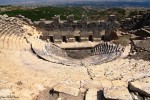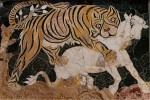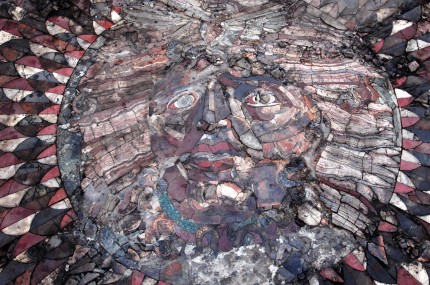 The unique mosaic of Medusa in the Odeon theater of Kibyra, an ancient Hellenistic city in southwest Turkey’s Burdur Province, has been revealed for the first time since it was discovered in 2009. In order to preserve it, the vast marble mosaic was covered in five layers of sand and gravel. Those layers have now been removed to allow restorers to assess its condition and devise a detailed restoration plan for next year. Once restoration is complete, the mosaic will be covered with glass to protect it while still making its special beauty accessible to visitors.
The unique mosaic of Medusa in the Odeon theater of Kibyra, an ancient Hellenistic city in southwest Turkey’s Burdur Province, has been revealed for the first time since it was discovered in 2009. In order to preserve it, the vast marble mosaic was covered in five layers of sand and gravel. Those layers have now been removed to allow restorers to assess its condition and devise a detailed restoration plan for next year. Once restoration is complete, the mosaic will be covered with glass to protect it while still making its special beauty accessible to visitors.
 What makes this piece so unique is a combination of size, design, location, materials and subject. So yeah, basically everything about it. The mosaic is 11 meters (36 feet) wide and fills in the entire orchestra area in front of the stage. In the center is a circular face of Medusa with a nimbus of wavy hair and serpents. From the central panel radiate geometric plates paired in contrasting colors that look like large feathers stretching all the way to the edge or the orchestra semi-circle. Marble plaques, some as slender as a single a millimeter thick, in red, white, green, brown, blue, red, grey and veined combinations of each form the design, a mosaic style called opus sectile which uses larger, irregularly shaped pieces rather than the small square tesserae used in the opus tessellatum style. It was created in the mid-third century A.D.
What makes this piece so unique is a combination of size, design, location, materials and subject. So yeah, basically everything about it. The mosaic is 11 meters (36 feet) wide and fills in the entire orchestra area in front of the stage. In the center is a circular face of Medusa with a nimbus of wavy hair and serpents. From the central panel radiate geometric plates paired in contrasting colors that look like large feathers stretching all the way to the edge or the orchestra semi-circle. Marble plaques, some as slender as a single a millimeter thick, in red, white, green, brown, blue, red, grey and veined combinations of each form the design, a mosaic style called opus sectile which uses larger, irregularly shaped pieces rather than the small square tesserae used in the opus tessellatum style. It was created in the mid-third century A.D.
 This is the only opus sectile Medusa known in the world. It’s the largest mosaic in Anatolia. It’s one of the best preserved of its size with 95% of the original material extant. It’s also the only Medusa mosaic found in the orchestra section of a Roman theater.
This is the only opus sectile Medusa known in the world. It’s the largest mosaic in Anatolia. It’s one of the best preserved of its size with 95% of the original material extant. It’s also the only Medusa mosaic found in the orchestra section of a Roman theater.
 The most exceptional elements, as far as I’m concerned, are the color combinations and the details of Medusa’s face. I think it looks incredibly contemporary. The eyes, nose, mouth and hair could have been drawn by Lucien Freud or Edvard Munch. I love opus sectile — the 4th century Tigress Attacking a Calf from the Basilica of Junius Bassus, now in the Capitoline Museums, has been a favorite of mine since childhood — but it usually has fairly distinct colored sections that are almost paint by numbers in their sharp outlines. Look at the rings the make up the irises and pupils, the crimson in the corner of the eyes and lips, the grain in the marble of the hair. This Medusa has a completely different feel than the tiger because of its remarkably organic composition.
The most exceptional elements, as far as I’m concerned, are the color combinations and the details of Medusa’s face. I think it looks incredibly contemporary. The eyes, nose, mouth and hair could have been drawn by Lucien Freud or Edvard Munch. I love opus sectile — the 4th century Tigress Attacking a Calf from the Basilica of Junius Bassus, now in the Capitoline Museums, has been a favorite of mine since childhood — but it usually has fairly distinct colored sections that are almost paint by numbers in their sharp outlines. Look at the rings the make up the irises and pupils, the crimson in the corner of the eyes and lips, the grain in the marble of the hair. This Medusa has a completely different feel than the tiger because of its remarkably organic composition.

If you think that this post was essentially an excuse to post this picture, you are correct. Such a spectacular piece of art, and a striking figure to border a performance stage. Odeons were small theaters built for musical shows — concerts, contests, poetry recitals — that often had roofs for acoustic purposes. The Kibyra odeon had seating for 3,600 and was used not just as a theater, but as a legal court and legislative chamber during winter when the roof made it the most comfortable building for public use.
EDIT: I initially described the Odeon as an amphitheater. Many thanks to Oliver Gilkes for his correction in the comments.